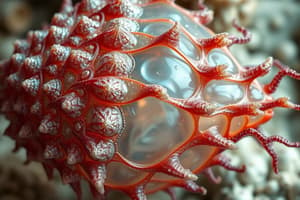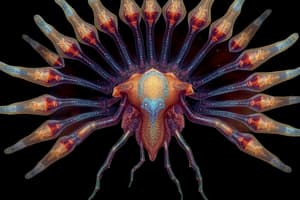Podcast
Questions and Answers
What does the term 'Polyplacophora' mean?
What does the term 'Polyplacophora' mean?
- Land-dwelling species
- Single shell structure
- Many plate bearing (correct)
- Aquatic mollusk
Where are Polyplacophora generally found?
Where are Polyplacophora generally found?
Close to shore, in the intertidal zone.
How many overlapping plates compose a Polyplacophora shell?
How many overlapping plates compose a Polyplacophora shell?
7-8 overlapping plates.
What is the girdle in Polyplacophora?
What is the girdle in Polyplacophora?
What does the mantle cavity in Polyplacophora contain?
What does the mantle cavity in Polyplacophora contain?
What is the function of bipectinate ctenidia?
What is the function of bipectinate ctenidia?
Describe the foot of Polyplacophora.
Describe the foot of Polyplacophora.
Polyplacophora can create suction against the substrate.
Polyplacophora can create suction against the substrate.
What is unique about the nervous system of Polyplacophora?
What is unique about the nervous system of Polyplacophora?
What are ganglia in the context of Polyplacophora?
What are ganglia in the context of Polyplacophora?
Polyplacophora have well-developed sensory organs such as tentacles and eyes.
Polyplacophora have well-developed sensory organs such as tentacles and eyes.
What are Aesthetes in Polyplacophora?
What are Aesthetes in Polyplacophora?
Describe the digestive tract of Polyplacophora.
Describe the digestive tract of Polyplacophora.
What function do sugar glands serve in Polyplacophora?
What function do sugar glands serve in Polyplacophora?
How far back do the fossil records of Polyplacophora extend?
How far back do the fossil records of Polyplacophora extend?
Flashcards are hidden until you start studying
Study Notes
Class Polyplacophora Overview
- Belongs to Phylum Mollusca, meaning "many plate-bearing."
- Typically features shells made up of 7-8 separate overlapping plates.
- Approximately 800 species identified, commonly known as "chitons."
- Size ranges from 3-10 cm in length.
Habitat and Environment
- Generally inhabits the intertidal zone, close to shore.
- Primarily lives on hard substrates, especially rocks.
Shell Composition
- The shell consists of 7-8 articulating plates located on the dorsal surface.
- Plates are partially to mostly embedded in the mantle tissue called the girdle.
- Multi-sectioned design allows adaptation to various substrate shapes.
Girdle and Mantle Cavity
- Girdle is the thick lateral mantle that embeds the shell plates.
- In many species, the girdle bears spicules that are secreted independently.
- The mantle cavity features two lateral grooves on each side of the body.
Bipectinate Ctenidia
- Each groove can hold up to 80 bipectinate ctenidia, acting as gills.
- Ctenidia divide the mantle cavity into incurrent and excurrent chambers for water flow.
- Water enters through gill cilia, while waste is expelled posteriorly.
- Blood flows through gill lamellae via countercurrent exchange for efficient respiration.
Locomotion and Suction
- The foot extends along the entire ventral surface, covered by the shell and girdle.
- Movement occurs through pedal waves of muscular activity.
- Capable of creating suction by pressing the girdle against a substrate and lifting the foot, an adaptation for high-wave areas.
Nervous and Sensory Systems
- Nervous system is simple and ladder-like; ganglia may be lacking or poorly developed in some species.
- Sensory systems are minimal, lacking tentacles and eyes, with the presence of Aesthetes.
- Aesthetes are sensory organs derived from mantle tissue that can function as light or chemoreceptors.
Digestive System
- Digestive tract is linear, with the mouth and anus at opposite ends.
- Primarily herbivorous, scraping food like algae from substrates; some species are carnivores.
- Sugar glands, a pair of pharyngeal glands, secrete amylase into the stomach for digestion.
Fossil Records and Evolution
- Fossil records date back approximately 500 million years.
- Polyplacophorans likely diverged early in molluscan evolution.
Studying That Suits You
Use AI to generate personalized quizzes and flashcards to suit your learning preferences.



